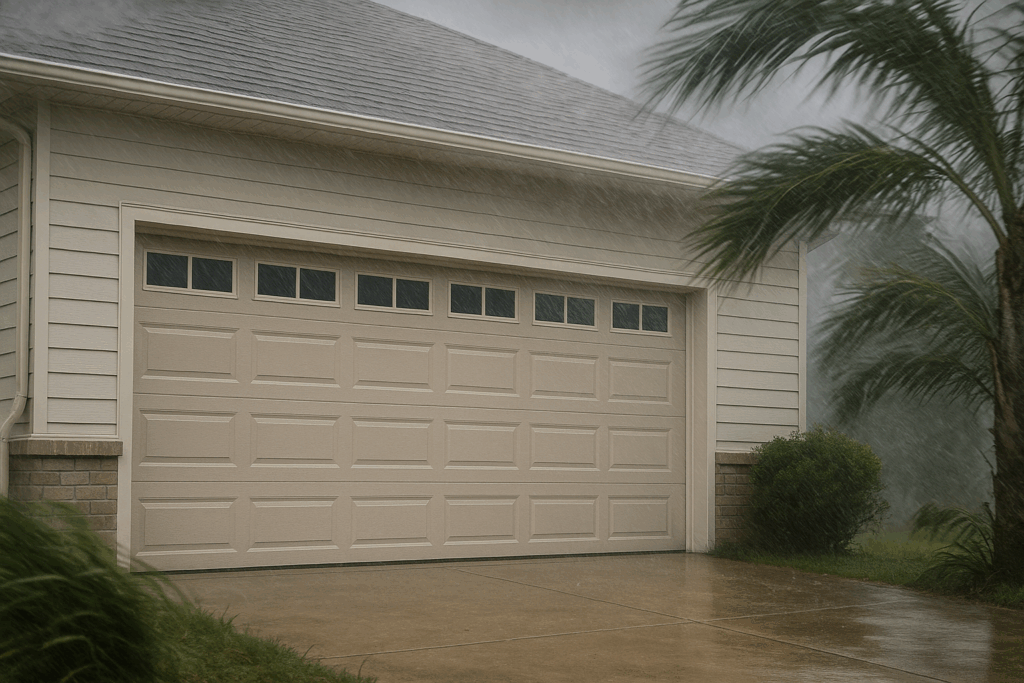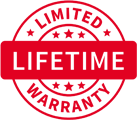Key Takeaways
1. Storm-rated garage doors are built to withstand hurricane-force winds, resist flying debris, and prevent catastrophic pressure buildup inside your home.
2. Simple steps, such as inspecting reinforcement bars, replacing worn trim, and keeping hardware lubricated, go a long way in strengthening your garage door before tropical storm season.
3. Anchor Doors & Service keeps you storm-ready with expert maintenance, trusted LiftMaster garage door openers, and 24-hour emergency repair service across Windsor, Essex County, and Chatham-Kent.
How a Storm-Rated Garage Door Protects Against Severe Weather
A storm-rated garage door is specifically designed to withstand the high winds, pressure changes, and flying debris that occur during hurricanes and severe storms. Since the garage door is the largest opening in most homes, it’s also the weakest point if it isn’t reinforced.
Once that opening gives way, winds can rush inside, creating pressure that can blow off the roof or push out walls. A storm-rated garage door uses heavier-gauge steel, reinforced struts, and impact-resistant materials to stay secure when standard doors with curb appeal would fail.
Here’s how it helps:
- Withstands hurricane-force winds
- Prevents roof and wall blowouts from design pressure buildup
- Resists flying debris impact
- Protects cars and stored valuables inside
- Meets hurricane-zone building code requirements
Following Hurricane Andrew in 1992, studies revealed that homes with weak or non-reinforced garage doors sustained some of the most severe structural integrity damage. In Florida today, local building codes require storm-rated garage doors in certain regions for this reason.
They’re tested to meet wind speeds of up to 150 mph or more, depending on the model and location requirements.
Key Features of a Storm-Rated Garage Door
Storm-rated residential garage doors are engineered with durability and protection in mind. They’re built to withstand hurricane-force winds, flying debris, and sudden pressure changes that can compromise your home’s structure. Here are the standout features that set them apart:
Reinforced Construction
Storm-rated garage doors are not built like ordinary doors; they’re engineered to take a beating. Crafted from heavy-gauge steel, aluminum, or other impact-resistant composites, these doors are designed to stand firm against hurricane-force winds and flying debris.
Standard garage doors, often made with thinner panels or lightweight wood, can warp or collapse under pressure. In contrast, storm-rated models include built-in struts, structural braces that run across each panel to keep the door rigid during high-speed winds.
Wind Resistance
Before a storm-rated garage door ever earns its certification, it must prove itself in testing labs. Doors are subjected to hurricane simulations, including hurricane winds and impacts from airborne debris.
Most are certified to handle wind speeds of 140-150 mph, and in hurricane hot zones like Florida’s HVHZ, some models are engineered for 170 mph or more.
Secure Bracing Systems
Storm-rated doors are reinforced with vertical and horizontal bracing systems that distribute wind pressure evenly across the surface. This prevents weak spots, panel bowing, or complete collapse under stress.
According to FEMA’s Building Science Branch, doors with reinforced bracing are far less likely to fail compared to unreinforced ones, making this one of the most critical features for storm survival.
Heavy-Duty Tracks and Hardware
A stronger door also means stronger support. To handle the added weight and pressure, storm-rated garage doors use industrial-grade tracks, rollers, and hinges. The tracks are often thicker and anchored more securely to prevent bending, while heavy-duty rollers and hinges keep the system running smoothly under load.
When a standard door is torn off its tracks, the sudden opening can unleash devastating pressure inside a home. Reinforced hardware makes sure the door stays put.
Sealing and Weatherproofing
Storm-rated doors are built to keep more than just wind at bay. Many come with enhanced perimeter seals and reinforced bottom weatherstrips, which block rain, wind-driven water, and debris from sneaking in through gaps.
While they won’t make your garage fully watertight, these seals can significantly cut down on water intrusion and reduce interior flooding risks.
Tips to Prepare Your Garage Door for Hurricane Season
When hurricanes strike, the garage door is often the first weak point in a home’s defense. As the largest opening, it can take on the full force of strong winds and flying debris.
If the door fails, pressure builds inside the home, putting your roof, walls, and everything inside at risk. In fact, FEMA has noted that garage door failure is one of the leading causes of structural damage during major storms for homeowners.
1. Inspect if Your Door Is Hurricane-Rated
When a storm hits, the garage door is often the first place high winds try to break through. If it gives way, the rest of the home improvement can quickly follow. Walls, roof, and everything inside are suddenly at risk.
That’s why taking a moment to inspect if your garage door is hurricane-rated is one of the smartest steps you can take before storm season.
Here’s how to tell:
- Look for reinforcement bars. Strong vertical bars running across the panels that keep the door rigid against heavy winds.
- Check for a label. Most hurricane-rated doors will have an identification label confirming they meet safety standards.
- Think about an upgrade. If your door is not reinforced, it may be worth investing in a hurricane-rated model. They usually run around $3,000, depending on size and design, but that’s a fraction of what storm damage could cost.
2. Check the Basic Function of the Door
A wind-rated garage door may look fine from the outside, but its true strength shows in how it operates day to day. If it does not open and close smoothly, or if you notice gaps or visible property damage, the door is already vulnerable and severe weather will only make those weaknesses worse.
Here’s what to look for:
- Smooth operation. The door should open and close without jerking, sticking, or hesitating.
- Visible gaps. Check for daylight peeking through the sides, top, or bottom, which signals weak sealing or misalignment.
- Damage. Replace doors with holes, soft spots, rust, or signs of structural weakness.
3. Inspect and Replace Worn Trim
The trim around your hurricane resistant garage door may seem like a minor detail, but during a storm, it plays a significant role. Trim helps seal out wind, rain, and debris that would otherwise sneak through the edges of your door.
Over time, though, it can crack, shrink, or peel away, leaving gaps that weaken your home’s defenses. Taking a few minutes to inspect and replace worn trim can make a noticeable difference in how well your insulated garage door withstands extreme weather conditions.
- Check for gaps or wear where the trim has pulled away or cracked.
- Replace damaged trim to block wind entry and moisture before it causes bigger problems.
4. Schedule Annual Maintenance
Your garage door works harder than almost any other moving system in your home, and yet it’s often overlooked until something breaks. Annual maintenance is like a health check-up for the door, ensuring that springs, rollers, and cables are strong enough to withstand everyday use and extreme conditions.
- Have a garage door professional from Anchor Doors check springs, rollers, bearings, and cables.
- Look for frayed cables or worn parts that could snap under stress.
- Keep everything lubricated to minimize strain and extend the system’s lifespan.
5. Lubricate and Maintain All Hardware
Every time your garage door moves, dozens of parts from hinges to springs to rollers are working together under pressure. Without proper lubrication, friction builds up and wears these components down faster, especially during heavy seasonal use.
You need to oil the hardware regularly to keep the door quieter and ensure it can withstand the extra stress that storms bring. It’s one of the simplest but most effective ways to extend the life of your garage door.
- Lubricate springs, rollers, and hinges at least once a year. to ensure smooth operation
- Use proper garage door lubricant (not WD-40) to protect against friction.
- Prevent extra strain so the door can handle storm conditions without added stress.
Storm-Ready Solutions Backed by Anchor Doors & Service
When storms roll in, the garage door is often the most vulnerable point of entry. A weak or outdated opener system can fail under stress, allowing wind, water, and debris to compromise the safety of your entire home.
That’s why preparing your garage is necessary. A storm-ready door can make all the difference in protecting both your home and the people inside it.
This is where Anchor Doors & Service provides real value for your garage door openers. With decades of experience, they know what it takes to keep doors working smoothly, even when conditions are at their worst:
- Expert service. Our garage door technicians repair and maintain Genie, Craftsman, Chamberlain, LiftMaster, and more, carrying stocked trucks so storm-season fixes don’t have to wait.
- Trusted LiftMaster options. Anchor recommends LiftMaster as the most reliable opener, offering Wi-Fi connectivity, smartphone control, and even models with built-in cameras.
- 24-hour emergency garage door repairs. When storms cause unexpected failures, their team is on call with round-the-clock emergency service across Windsor, Essex County, and Chatham-Kent.
Prepare your garage for storm season today. Contact Anchor Doors & Service for expert guidance.
FAQs
A storm-rated garage door is specifically designed and reinforced to withstand high wind protection and flying debris during hurricanes or severe storms. They are tested to meet local code requirements, wind ratings or impact ratings in hurricane-prone areas to withstand storms.
Check for reinforcement bars running vertically or horizontally across the panels and look for an identification label that confirms hurricane protection or wind-load rating. If you don’t see these, your door may not have storm protection.
The hurricane garage door is the largest opening in most homes. If it fails during a storm, wind pressure can build up inside the house, leading to roof or water damage, wall collapse, and major structural failure. A reinforced door with garage door maintenance from a professional helps prevent this.
On average, a hurricane-proof garage door installation costs around $3,000, depending on the size, energy efficiency, wind load-rated configurations, model, and features. While more expensive upfront, the investment can save thousands in storm-related repairs.
Yes. Regular checks include checking reinforcement bars, replacing worn weather seals, wind load requirements, and keeping all moving parts lubricated. Annual professional maintenance ensures the door remains strong enough to handle severe weather.

















